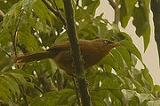
Rufous Babbler
Encyclopedia
The Rufous Babbler is an Old World babbler
endemic to the Western Ghats
of southern India. It is dark brown and long tailed, and is usually seen foraging in noisy groups along open hillsides grass or forest.
They have a loud ringing Treenh-treenh call.
Old World babbler
The Old World babblers or timaliids are a large family of mostly Old World passerine birds. They are rather diverse in size and coloration, but are characterised by soft fluffy plumage. These are birds of tropical areas, with the greatest variety in Southeast Asia and the Indian Subcontinent...
endemic to the Western Ghats
Western Ghats
The Western Ghats, Western Ghauts or the Sahyādri is a mountain range along the western side of India. It runs north to south along the western edge of the Deccan Plateau, and separates the plateau from a narrow coastal plain along the Arabian Sea. The Western Ghats block rainfall to the Deccan...
of southern India. It is dark brown and long tailed, and is usually seen foraging in noisy groups along open hillsides grass or forest.
Description
This babbler is large and dark olive brown above with a grey forehead. The wing feathers have a rufous tinge. The feathers of the forehead have black shafts. The iris is pale white to yellow and the lores are dark. The underside is bright rufous, paler on the center of the throat and belly. The nominate form (type location: Mananthawadi) is found in the Western Ghats north of the Palghat Gap while hyperythra found to the south is said to be more richly coloured. They are 25–26 cm long with a wing of 8.7-9.0 cm. The tail is about 11-11.5 cm long.Habitat and distribution
This species if found only in the Western Ghats south of Mahabaleshwar, the Palni and Shevaroy hills. They are found mainly close to the ground where they feed on insects and berries but will also make use of trees. The usual habitat is open forest, scrub or grassy hillsides.Behaviour and ecology
The breeding season is mainly from February to November and the nest is a small cup in the fork of a tree. The eggs, ranging from two to four but usually three are dark glossy blue.They have a loud ringing Treenh-treenh call.

